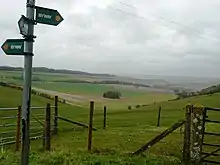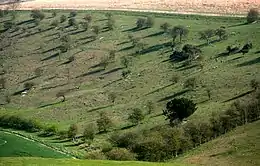Streatley Warren
Streatley Warren is a 31.3-hectare (77-acre) biological Site of Special Scientific Interest west of Streatley in Berkshire.[1][2] It is in the North Wessex Downs, which is an Area of Outstanding Natural Beauty.[3]
| Site of Special Scientific Interest | |
 | |
| Area of Search | Berkshire |
|---|---|
| Grid reference | SU 554 807[1] |
| Interest | Biological |
| Area | 31.3 hectares (77 acres)[1] |
| Notification | 1988[1] |
| Location map | Magic Map |
Geography

Zoom shot of afternoon sunshine on the sparse woodland on the steep southern slope of the dry valley that forms Streatley Warren.
The site runs along The Ridgeway.[4] The site features terraced land in a dry chalk valley.[5]
History
There is evidence discovered that the terracing formed on the site is of Iron Age creation, when an archaeological dig was started on the site in 1948.[5] It is also believed that Romans continued to use this land for farming.[5] During medieval times the land was used for farming rabbits.[6]
Access
Streatley Warren is open access land, but entry is only allowed between November and February.[7]
Flora
The site has the following flora:[4][3]
Plants
- Coeloglossum
- Gymnadenia conopsea
- Filipendula vulgaris
- Anthyllis vulneraria
- Campanula rotundifolia
- Gentianella anglica
- Festuca rubra
- Festuca ovina
- Briza media
- Helictotrichon pratense
- Koeleria macrantha
- Bromus erectus
- Carex flacca
- Plantago media
- Cirsium acaule
- Leontodon hispidus
- Sanguisorba minor
- Scabiosa columbaria
- Thymus praecox
- Gentianella amarella
- Asperula cynanchica
- Linum catharticum
- Centaurea nigra
- Pimpinella saxifraga
- Origanum vulgare
References
- "Designated Sites View: Streatley Warren". Sites of Special Scientific Interest. Natural England. Retrieved 24 October 2019.
- "Map of Streatley Warren". Sites of Special Scientific Interest. Natural England. Retrieved 24 October 2019.
- "Streatley Warren citation" (PDF). Sites of Special Scientific Interest. Natural England. Retrieved 24 October 2019.
- "Streatley Warren – 18 February 2015 « Reading & District Natural History Society". Rdnhs.org.uk. Retrieved 2017-02-11.
- "myADS" (PDF). Archaeology Data Service. Retrieved 2017-02-11.
- Else, David; Bardwell, Sandra; Dixon, Belinda; Dragicevic, Peter (2007). Walking in Britain - David Else, Sandra Bardwell, Belinda Dixon, Peter Dragicevic - Google Books. ISBN 9781741042023. Retrieved 2017-02-11.
- "Streatley Warren – 18 February 2015". Reading and District Natural History Society. Retrieved 24 October 2019.
| Wikimedia Commons has media related to Streatley Warren. |
This article is issued from Wikipedia. The text is licensed under Creative Commons - Attribution - Sharealike. Additional terms may apply for the media files.